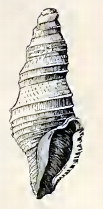Filodrillia tricarinata facts for kids
Quick facts for kids Filodrillia tricarinata |
|
|---|---|
 |
|
| Drawing of a shell of Filodrillia tricarinata | |
| Scientific classification | |
| Synonyms | |
|
Filodrillia tricarinata is a type of sea snail. It's a small mollusk that lives in the ocean. These snails belong to a group called gastropods, which includes snails and slugs. They are part of the family Borsoniidae. This particular snail was first described in 1878.
What Does Filodrillia tricarinata Look Like?
This sea snail has a small shell, usually about 6 millimeters (about a quarter of an inch) long and 2 millimeters wide. Its shape is long and spindle-like.
The shell has six rounded sections called whorls, which spiral around. The very first 1½ whorls at the top are blunt. Unlike some other snails, this shell has no folds or pleats. Instead, it has three delicate ridges, or "keels," running along it. One of these keels is right on the suture, which is the line where the whorls join. The areas between these ridges are slightly curved inwards.
The opening of the shell, called the aperture, is oval-shaped. At the back of the opening, there's a wide and deep notch called the sinus. The outer edge of the opening, known as the lip, is thicker than the rest of the shell.
Shell Variations: How Filodrillia tricarinata Can Differ
Scientists have noticed that the shells of Filodrillia tricarinata can look quite different from one another. This means they vary a lot in their shape and how their surface is decorated.
For example, a shell might have three sharp spiral ridges on each of its main whorls. Another shell might have only two ridges on the first few whorls, with a third ridge appearing later. Some shells are shorter and stronger, with two very strong spiral ridges. Others might be long and narrow, with four spiral ridges on each whorl.
Sometimes, there are also faint lines running across the shell, which can make the intersections with the spiral ridges bumpy. Even though these shells can look so different, scientists believe they are all the same species because they have found many intermediate forms that show a complete range of changes between them.
Where Does Filodrillia tricarinata Live?
This sea snail is endemic to Australia, meaning it is found only there. You can find it living off the coasts of South Australia, New South Wales, Tasmania, and Victoria.

